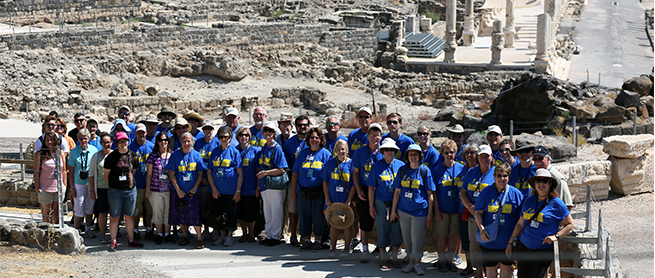
Why go to Israel? Simply put, do you want to have a greater appreciation for and understanding of God’s redemptive plan revealed in His Word? God’s redemptive plan took place in the historical past. And, that past has a location—the land of Israel. Just like sharing the same language is the key to understanding each other’s communication, understanding the geography of historical events illuminates those events in the Bible. Geography shapes history.
Why that Place?
 Why was the real-estate of Canaan the “promised land” setting for God’s redemptive plan? Would not Hawaii or the Bahamas have been a better choice? Why was Caesarea Philippi Jesus’ choice for Peter’s famous confession (Matt 16)? Why is Megiddo (aka: Armageddon) the location of the final battle between good and evil? Why did Jesus launch His earthly ministry in the Galilean region as opposed to Jerusalem? Understanding geography opens up new insights to why God’s plan happened the way that it did.
Why was the real-estate of Canaan the “promised land” setting for God’s redemptive plan? Would not Hawaii or the Bahamas have been a better choice? Why was Caesarea Philippi Jesus’ choice for Peter’s famous confession (Matt 16)? Why is Megiddo (aka: Armageddon) the location of the final battle between good and evil? Why did Jesus launch His earthly ministry in the Galilean region as opposed to Jerusalem? Understanding geography opens up new insights to why God’s plan happened the way that it did.
The Land—the Crossroads of the World
The small piece of real-estate known as either Israel, Palestine, Canaan, or the “promised land” forms a land bridge between three continents—Africa, Europe, and Asia. This land was at the intersection of the world during the ancient times. World travel dictated that the travelers go through Israel.
It was to this “crossroads of the world,” that God called Abraham to live out his faith in Him. God placed Israel at the center of the known world so that the world may know about the one and only Creator and Redeemer God.
The Land—the Testing Ground of Faith
God did not establish His people in an isolated and beautiful land of ease and relaxation like Hawaii or the Bahamas. He brought His people to a place of testing. Because of its strategic position, maintaining an independent centralized government was always politically challenging. Only three times in history has the land been under its own centralized rule—the time of David and Solomon’s empire, the Maccabean times (1-2nd century BC), and today.
Furthermore, the land is challenging in many other ways. The terrain of the land is rugged and not given toward ease of travel. Travel is constricted to certain common trade routes which empires fought to control. The climate of the land is volatile and can easily lead the land into drought conditions—as so often seen in Bible times. The agriculture of the land is complex—varying from fertile valleys in the north, difficult terraced farming in the hilly central region, and very little agriculture in the south. Religiously, well, let’s say it is complicated—just as it was in Abraham’s day and throughout the history of Israel including today.
To this testing ground of faith God called His people to live out their belief in the one true God who could and would provide for them in this extremely complicated and challenging location.
Pilgrims to the Land
To this land a group of forty-six folks, mostly from Faith traveled to gain a better understanding of God’s redemptive plan. Just as Israel was called to be at the crossroads of the world, every believer today is called to be the light in his sphere of influence while facing his testing ground with the faith of Abraham in order that the world may know about the one true God.
“The Land of the Messiah” blogs will be a series detailing the lessons from the locations we visited in the order that we visited them.
Before leaving, the Faith Israel group met at the Opperman’s for a time of food and fellowship:
 Church
Church